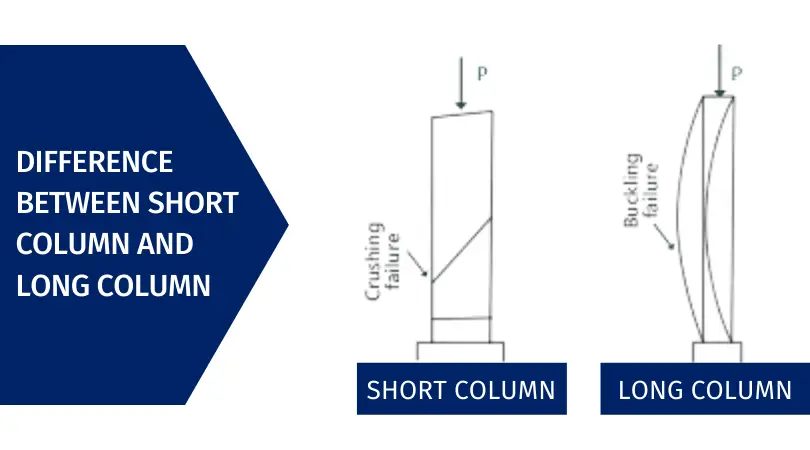Difference Between Short Column and Long Column
Table of Contents
 Difference Between Short Column and Long Column
Difference Between Short Column and Long Column
- There are many differences between the Short column and the Long column, some of which are given below.
- A short column is a column whose ratio of its actual or effective length and its minimum lateral dimension is less than or equal to 12. A column with such features is called a short column.
- The formula by which a short column can be calculated is ( lef / b ) <= 12 . Where lef = Effective Length of a column, b = Least lateral dimension of a column.
- If the average working length and minimum lateral size are less than or equal to 12, then it is called a short column.
- In the case of the short column, the effective length to a minimum radius of gyration ratio is less than or equal to 40.
- In the case of the short column, the buckling tendency is very low as compared to the long columns.
Also Read: Difference Between Cement Plaster and Gypsum Plaster
- In the case of the short column, the crushing tendency is very high as compared to the long columns.
- In the case of a short column, the load-carrying capacity is higher as compared to the long columns of the same cross-sectional area.
- In the case of a short column, the failure is due to their crushing.
- In the case of a short column, the radius of gyration is more as compared to the long columns.
- The short column has the capacity to carry a large load due to its low height as compared to the long columns.
- The short columns are under great pressure and compressive stress.
- In the case of the short column, the slenderness ratio is less than 45.
- In the case of the short column, the columns have a larger lateral dimension as compared to their height.
- The short column is much stronger than the longer column and is highly recommended.
- Long or thin is the column whose ratio of its actual or effective length and its minimum lateral dimension is not less than 12. A column with such features is called the long column.
- In long columns, the allowable values of pressure or stress in concrete and steel, which are used for small columns, should be multiplied by the coefficient Cr given by the following formula.
- Cr = 1.25 – lef / 48 b , where Cr = Reduction Coefficient, Where lef = Effective Length of a column, b = Least lateral dimension of a column.
- If the average working length and minimum lateral size are greater than 12, then it is called a long column.
- In the case of the long column, the effective length to a minimum radius of gyration ratio is greater than 40.
- In the case of the long column, the Long and cylindrical pillars are easy to buckle down as compared to the short columns.
- In the case of the long column, the crushing tendency is very low as compared to the short columns.
Also Read: What Is Lintel? | Function of Lintel | Types of Lintel
- The load-bearing capacity of a long column is less than that of a short column of a similar cross-sectional area.
- In a civil structure, all long columns fail due to their buckling.
- In the case of the long column, the radius of gyration is less as compared to the short columns.
- The long column has the capacity to carry less load due to its high height as compared to the short columns.
- Long columns are subject to buckling pressure or stress.
- In the case of the long column, the slenderness ratio is more than 45.
- In the case of the long column, the columns have a smaller lateral dimension as compared to their height.
- The long column is much weaker than the short column and is usually not preferred.
[note note_color=”#F2F2F2 ” text_color=”#333333″ radius=”3″ class=”” id=””]
Like this post? Share it with your friends!
Suggested Read –
- What Is Plastering | What Is Pointing | Difference Between Plastering and Pointing |
- What Is Timber ? | What Is Lumber ? | What Is Lumber Used for ? | Lumber Vs Wood | Difference Between Lumber and Timber | Standard Wood Size | What Is Timber Used for ?
- Concrete Slump Test | Principle of Slump Test | What Is Slump Test ? | How to Measure Concrete Slump? | Slump Test Results | Concrete Slump Test Procedures |
- Difference Between Coarse Aggregate and Fine Aggregate | What Is Coarse Aggregate? | What Is Fine Aggregate? | Advantage of coarse aggregates | Advantage of Fine Aggregate
- Concrete Vs Cement | Definition of Cement and Concrete | Composition of Cement and Concrete | Types of Cement and Concrete | Properties of Cement and Concrete | Uses of Cement and Concrete | Advantages of Cement and Concrete | Disadvantages of Cement and Concrete
[/note]
Originally posted 2021-08-23 06:32:12.
